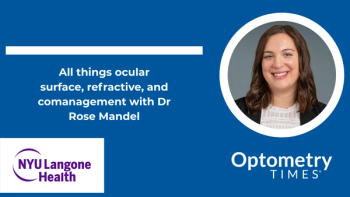
Cell therapy for corneal endothelial disease gains traction
Groundbreaking treatment for patients with bullous keratopathy approved in Japan.
Reviewed by Edward Holland, MD
In March 2023, Japan’s Pharmaceuticals and Medical Devices Agency (PMDA) approved Aurion Biotech’s allogeneic cell therapy, Vyznova, to treat patients with bullous keratopathy. This approval is believed to be the first for an allogenic cell therapy for corneal endothelial disease.
Healthy cells from a donor
The eyes of patients with corneal endothelial cell damage cannot regenerate these cells. Following corneal disease or injury, the number of cells decrease and vision can be lost. This new cell therapy improves on the current therapies (penetrating and endothelial keratoplasties) with simplified treatment, and potential complications such as graft detachment, transplant rejection, dislocation, irregular astigmatism, and infection have been eliminated, according to the news release.
The cell manufacturing process is fascinating, according to Edward Holland, MD, chair of Aurion Biotech’s Medical Advisory Board, director of cornea services at Cincinnati Eye Institute, and a professor of ophthalmology at the University of Cincinnati in Ohio.
Holland explained that the number of human corneal endothelial cells (HCECs) in each individual is finite and that over time they will degrade or deteriorate because of age, disease, or surgical trauma. “Once HCECs are gone, they’re gone for good,” he said.
Until recently, getting fully differentiated HCECs to reproduce in vitro proved challenging. Shigeru Kinoshita, MD, PhD, of the Kyoto Prefectural University of Medicine (KPUM), overcame this hurdle with a breakthrough innovation that enabled these cells to reproduce in the laboratory.1,2
A powerful feature of these manufactured cells is that they are fully differentiated, meaning they do not need to learn to become endothelial cells (unlike stem cells). HCECs have all of the inherent characteristics of endothelial cells because they are endothelial cells. This gives practicing ophthalmologists a great deal of confidence in their efficacy and safety profile.
Treatment
Holland noted that during treatment, the endothelial cells are injected intracamerally into the eye, where they repopulate into a healthy monolayer and remove fluid from the cornea, which decreases corneal edema. The cell therapy procedure is minimally invasive and can be performed relatively rapidly, with a recovery period of approximately 2 to 3 hours for patients.
“The procedure is quite elegant,” Holland said. “We prepare the patient’s eye as we would for any outpatient ocular surgery. We then make a small incision into the patient’s anterior chamber. With a standard cannula, we ‘polish off’ the diseased endothelium in the central area of the cornea.”
Holland noted that the surgeon can implant the cells into the patient’s anterior chamber using a 27-gauge needle and syringe. “Then the patient lies on his or her stomach for 3 hours, which enables the cells to settle into place and reform a monolayer,” he added. “The next day, the patient can resume most normal activities.”
Experience to date
This procedure is the life’s work of Kinoshita, who noted the procedure “offers the potential to completely transform the treatment paradigm for corneal endothelial disease, with an ample supply of fully differentiated, allogeneic corneal endothelial cells; a minimally invasive, elegant procedure; and potentially less onerous recovery for patients.”
Kinoshita and his colleagues conducted a first-in-human trial of subjects with bullous keratopathy. The 2-year outcomes of the first 11 participants were published in 2018,1 and 5-year outcomes were published in 2021.2 Kinoshita/KPUM out-licensed this intellectual property to Aurion Biotech for clinical development.
Along with a US team of corneal surgeons that included Elizabeth Yeu, MD; John Berdahl, MD; and Matt Giegengack, MD, Holland performed the first cell therapy studies outside of Japan, at the Clinica Quesada in San Salvador, El Salvador, from 2020 to 2022.
Results
Aurion reported that treated patients “have experienced clinically meaningful and sustained improvements in key measures of corneal health: visual acuity, central corneal thickness, and endothelial cell density.”1
“The results are just remarkable,” Holland said. “Even in extremely edematous corneas with bullous keratopathy eyes, we’ve seen tremendous anatomic and functional improvements with full recovery of vision.” Holland pointed out that ophthalmologists will measure the central cornea thickness to determine whether the corneal edema has decreased. “The functional measure is the best-corrected visual acuity [BCVA],” he said. “After treatment, the corneal edema is reduced to normal levels, and their visual acuity is significantly improved. It’s remarkable.”
In total, 130 patients with corneal endothelial disease have been treated with this cell therapy.
Cell therapy vs standard of care
Cell therapy differs from endothelial keratoplasty in several important ways, Holland explained. Although corneas are the most frequently transplanted organ, worldwide there is a chronic shortage. For every 70 diseased eyes, there is only 1 donor cornea available.3 And endothelial keratoplasty requires the use of 1 donor cornea for each diseased eye. In contrast, Aurion can manufacture up to 100 doses from a single donor (enough to treat 100 eyes) and may be able to manufacture more than 1000 doses in the near future. Once approved throughout the world, Aurion’s cell therapy manufacturing could effectively eliminate this worldwide chronic shortage of donor corneal tissue.
Next, the postoperative recovery period for patient experience with cell therapy is much less onerous than for endothelial keratoplasty, where patients must lie flat on their backs for 1 to 2 days in order for the donor corneal tissue graft to adhere properly to the patient’s cornea. Even with cooperative patients there is still a significant graft detachment rate, with endothelial keratoplasty, especially with the Descemet membrane endothelial keratoplasty procedure.2
In addition, the number of cells transplanted with cell therapy will be significantly greater than with endothelial keratoplasty, which will result in longer corneal surgical success and a reduction in the need for repeat surgery. Equally important, this procedure is quite accessible to the broader ophthalmology community, as compared with endothelial keratoplasty, which is performed almost exclusively by corneal specialists. “It’s my expectation that a larger population of ophthalmologists will embrace cell therapy, for all of these reasons,” Holland said.
Japanese clinical data
Japan’s PMDA approved Vyznova based on results achieved in 65 patients in 3 Japanese clinical trials, including a first-in-human trial with 38 patients, an endothelial cell dose ranging trial with 15 patients, and a confirmatory trial with 12 patients.3
The primary efficacy end point of these studies was the proportion of patients who achieved a corneal endothelial cell density of 1000 or more cell/mm2; the main secondary efficacy end points were the proportion of subjects with a central corneal thickness (CCT) of less than 630 microns and the proportion of subjects with a 2-line (0.2 logarithm of the minimum angle of resolution [logMAR]) improvement or greater in BCVA.
In the US, Aurion Biotech is preparing to submit an investigational new drug application to initiate clinical trials, with additional clinical development plans under way in the European Union.
In Japan, now that the team has received regulatory approval, the next step is to solicit reimbursement approval. The team anticipates that effort will involve the better part of the rest of 2023.
References:
1. Kinoshita S, Koizumi N, Ueno M. Injection of cultured cells with a rock inhibitor for bullous keratopathy. N Engl J Med. 2018;378(11):995-1003. doi:1056/NEJMoa1712770
2. Numa K, Imai K, Ueno M, et al. Five-year follow-up of first 11 patients undergoing injection of cultured corneal endothelial cells for corneal endothelial failure. Ophthalmology. 2021;128(4):504-514. doi:10.1016/j.ophtha.2020.09.002
3. Gain P, Jullienne R, He Z, et al. Global survey of corneal transplantation and eye banking. JAMA Ophthal. 2016;134(2):167-173. doi:10.1001/jamaophthalmol.2015.4776
Newsletter
Want more insights like this? Subscribe to Optometry Times and get clinical pearls and practice tips delivered straight to your inbox.



















































.png)


